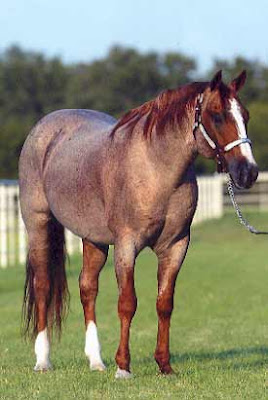A high percentage of Arabs have the color modifying grey gene (G). These horses are born their base coat color and fade to white over the course of their lifetime. How quickly they fade is also determined by genetics. Some greys may develop a "flea-bitten" look or be marked by color in other fashions (eg, "bloody shoulder").
Flea-bitten grey stallion *Carycyn (b. 1961, Comet x Cerekiew (by Wielki Szlem))
I'll start out with simple Mendelian genetics. All horses have two copies of either the black (E) or red (e) gene, one copy inherited from each parent. Since red is recessive, all chestnut horses are (ee- homozygous). Black horses may be either (EE - homozygous) or (Ee - heterozygous).
Chestnut stallion Adlan (b. 1992, Adl x Fenoun (by Hafid Anter))
Black stallion Darq+++ (b. 1969, Raffon++ x Jo-Vall (by Jokkar))
Bay coats are the result of the influence of the Agouti (A) gene. This gene acts by causing depigmentation of black hair on most of the body, leaving red coloring with black points. To express the Agouti gene, a horse must have at least one copy of the black (E) gene. A chestnut horse may have the (A) gene, but it will not express because his coat is already red. Therefore, the genetics for coat colors are as follows:
- BLACK: EEaa or Eeaa (E_aa) + gg (no grey modifier)
- BAY: EEAA, EEAa, EeAA, or EeAa (E_A_ ) + gg
- CHESTNUT: eeAA, eeAa, or eeaa (ee_ _ ) + gg
- GREY: any of the above in combination with GG or Gg (G_ )
Bright bay stallion El Perfecto (b. 1988, *Vallehermoso x Example (by *Barich de Washoe))
Within each color, there is a wide range of expression. Bays or chestnuts can appear nearly black. Chestnuts can be almost blonde with flaxen manes and tails. The purebred Arabian gene pool contains no dilute genes (cream, silver dapple, champagne, etc).
An interesting note: before the advent of genetic tests to determine coat color, the stallion Fire An Ice was able to be registered with the Palomino Horse Association based on appearance alone, even though he doesn't have the necessary cream gene to be a true gold!
Fire An Ice (Gold N Ali x Tu-Flame (by Baske-Tu)), 1990 chestnut stallion registered both AHA and PHA
There is a misconception that Arabians cannot be pinto and still be purebred. In actual fact, pure Arabians cannot be tobiano or overo, but they can be sabino. Sabino expression may be minimal (some white on the legs, a blaze that covers part of the lower lip, small belly spots, etc). They may also be extreme with lots of white. Pinto Arabians have been described as "parti-colored" in earlier literature. While sabino markings have long been considered undesirable or a sign of impurity in the United States, desert tribes did not consider sabino horses to be inferior.
An example of a wildly-marked purebred pinto Arab was the lovely champion mare WA Outrageous+/
WA Outrageous+/ (b. 1999, Khartoon Khlassic x Gladiola Bey (by Great Lad))
Arabians also may have some roaning, although it is not the same gene that causes a true roan like in other breeds (classified by dark head and points along with a lighter colored, nearly white body). Rabicano roaning is often partnered with sabino expression in Arabs. Rabicanos usually have a "skunk tail," one that is partially white.
True red roan:
1992 Quarter Horse (AQHA) stallion Peptoboonsmal
Chestnut rabicano:
Akid Ali Zafar, 1979 Arabian stallion (*Rasheek x Akid Bint Rualla (by TheEgyptianPrince))
I will post more on color genetics at another time. To conclude today's post, here are two hard and fast rules on inheritance of color:
- Two non-grey parents cannot have grey offspring. When the grey modifier gene is inherited it is ALWAYS expressed--if a horse isn't grey, it doesn't carry the (G) gene.
- Two chestnut parents cannot have offspring of any other color. The chestnut gene is recessive, and therefore all individuals who express this gene are homozygous (ee).








Very good. This article is well researched on a very hard subject. It is well presented.
ReplyDeleteI wrote an article in Arabian color genetics for Arabian Horse Express in 1996. (Their own typo said that two blacks will always produce a bay. That was supposed to be black).
I enjoyed reading this.
Patricia Merkle
i love Arabians/ i love horses
ReplyDeleteI love Arabians too. Horses are my favorite animals!
ReplyDeleteThis was very informative, thank you. I am always eager to learn all and everything about horses and Arabians are just a fantastic breed <3
ReplyDeleteHello - can an Arabian have Dun coloring? My gelding has a dorsal stripe and zebra stripes on his front legs. He's always been registered as a purebred.
ReplyDeleteEye catching colors. Jacket Back Digitizing Nice post.
ReplyDelete